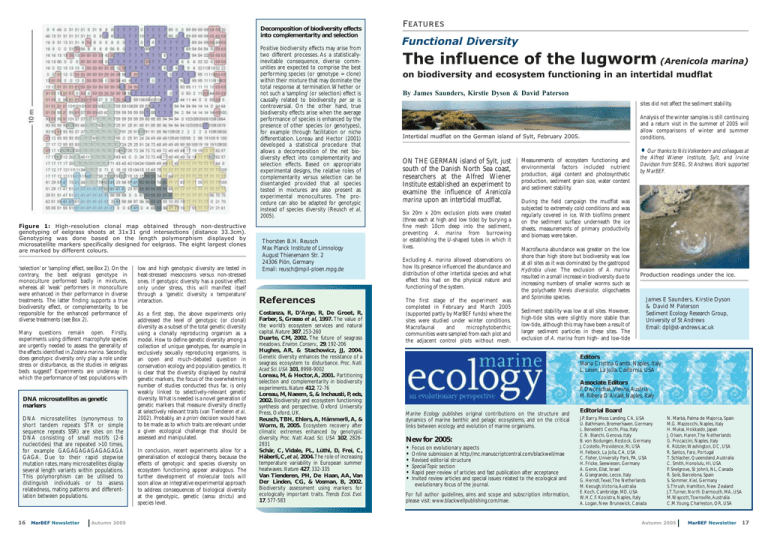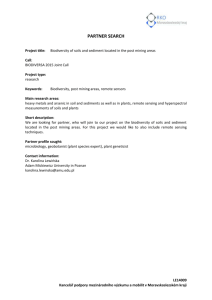The influence of the lugworm
advertisement

Decomposition of biodiversity effects into complementarity and selection Positive biodiversity effects may arise from two different processes. As a statisticallyinevitable consequence, diverse communities are expected to comprise the best performing species (or genotype = clone) within their mixture that may dominate the total response at termination. Whether or not such a ‘sampling’ (or selection) effect is causally related to biodiversity per se is controversial. On the other hand, true biodiversity effects arise when the average performance of species is enhanced by the presence of other species (or genotypes), for example through facilitation or niche differentiation. Loreau and Hector (2001) developed a statistical procedure that allows a decomposition of the net biodiversity effect into complementarity and selection effects. Based on appropriate experimental designs, the relative roles of complementarity versus selection can be disentangled provided that all species tested in mixtures are also present as experimental monocultures. The procedure can also be adapted for genotypic instead of species diversity (Reusch et al, 2005). Figure 1: High-resolution clonal map obtained through non-destructive genotyping of eelgrass shoots at 31x 31 grid intersections (distance 33.3cm). Genotyping was done based on the length polymorphism displayed by microsatellite markers specifically designed for eelgrass. The eight largest clones are marked by different colours. ‘selection’ or ‘sampling’ effect, see Box 2). On the contrary, the best eelgrass genotype in monoculture performed badly in mixtures, whereas all ‘weak’ performers in monoculture were enhanced in their performance in diverse treatments. The latter finding supports a true biodiversity effect, or complementarity, to be responsible for the enhanced performance of diverse treatments (see Box 2). Many questions remain open. Firstly, experiments using different macrophyte species are urgently needed to assess the generality of the effects identified in Zostera marina. Secondly, does genotypic diversity only play a role under stress or disturbance, as the studies in eelgrass beds suggest? Experiments are underway in which the performance of test populations with DNA microsatellites as genetic markers DNA microsatellites (synonymous to short tandem repeats STR or simple sequence repeats SSR) are sites on the DNA consisting of small motifs (2-6 nucleotides) that are repeated >10 times, for example GAGAGAGAGAGAGAGA GAGA. Due to their rapid stepwise mutation rates, many microsatellites display several length variants within populations. This polymorphism can be utilised to distinguish individuals or to assess relatedness, mating patterns and differentiation between populations. 16 MarBEF Newsletter Autumn 2005 low and high genotypic diversity are tested in heat-stressed mesocosms versus non-stressed ones. If genotypic diversity has a positive effect only under stress, this will manifest itself through a ‘genetic diversity x temperature’ interaction. As a first step, the above experiments only addressed the level of genotypic (or clonal) diversity as a subset of the total genetic diversity using a clonally reproducing organism as a model. How to define genetic diversity among a collection of unique genotypes, for example in exclusively sexually reproducing organisms, is an open and much-debated question in conservation ecology and population genetics. It is clear that the diversity displayed by neutral genetic markers, the focus of the overwhelming number of studies conducted thus far, is only weakly linked to selectively-relevant genetic diversity. What is needed is a novel generation of genetic markers that measure diversity directly at selectively relevant traits (van Tienderen et al, 2002). Probably, an a priori decision would have to be made as to which traits are relevant under a given ecological challenge that should be assessed and manipulated. In conclusion, recent experiments allow for a generalisation of ecological theory, because the effects of genotypic and species diversity on ecosystem functioning appear analogous. The further development of molecular tools will soon allow an integrative experimental approach to address consequences of biological diversity at the genotypic, genetic (sensu strictu) and species level. Thorsten B.H. Reusch Max Planck Institute of Limnology August Thienemann Str. 2 24306 Plön, Germany Email: reusch@mpil-ploen.mpg.de References Costanza, R, D’Arge, R, De Groot, R, Farber, S, Grasso et al, 1997. The value of the world’s ecosystem services and natural capital. Nature 387, 253-260 Duarte, CM, 2002. The future of seagrass meadows. Environ. Conserv., 29, 192-206 Hughes, AR, & Stachowicz, JJ, 2004. Genetic diversity enhances the resistance of a seagrass ecosystem to disturbance. Proc. Natl. Acad Sci. USA 101, 8998-9002 Loreau, M, & Hector, A, 2001. Partitioning selection and complementarity in biodiversity experiments. Nature 412, 72-76 Loreau, M, Naeem, S, & Inchausti, P, eds, 2002. Biodiversity and ecosystem functioning: synthesis and perspective. Oxford University Press, Oxford, UK. Reusch, TBH, Ehlers, A, Hämmerli, A, & Worm, B, 2005. Ecosystem recovery after climatic extremes enhanced by genotypic diversity. Proc. Natl. Acad. Sci. USA 102, 28262831 Schär, C, Vidale, PL, Lüthi, D, Frei, C, Häberli, C, et al, 2004. The role of increasing temperature variability in European summer heatwaves. Nature 427, 332-335 Van Tienderen, PH, De Haan, AA, Van Der Linden, CG, & Vosman, B, 2002. Biodiversity assessment using markers for ecologically important traits. Trends Ecol. Evol. 17, 577-583 Features Functional Diversity The influence of the lugworm (Arenicola marina) on biodiversity and ecosystem functioning in an intertidal mudflat By James Saunders, Kirstie Dyson & David Paterson sites did not affect the sediment stability. Intertidal mudflat on the German island of Sylt, February 2005. Analysis of the winter samples is still continuing and a return visit in the summer of 2005 will allow comparisons of winter and summer conditions. • ON THE GERMAN island of Sylt, just south of the Danish North Sea coast, researchers at the Alfred Wiener Institute established an experiment to examine the influence of Arenicola marina upon an intertidal mudflat. Six 20m x 20m exclusion plots were created (three each at high and low tide) by burying a fine mesh 10cm deep into the sediment, preventing A. marina from burrowing or establishing the U-shaped tubes in which it lives. Excluding A. marina allowed observations on how its presence influenced the abundance and distribution of other intertidal species and what effect this had on the physical nature and functioning of the system. The first stage of the experiment was completed in February and March 2005 (supported partly by MarBEF funds) where the sites were studied under winter conditions. Macrofaunal and microphytobenthic communities were sampled from each plot and the adjacent control plots without mesh. Measurements of ecosystem functioning and environmental factors included nutrient production, algal content and photosynthetic production, sediment grain size, water content and sediment stability. Our thanks to Nils Volkenborn and colleagues at the Alfred Wiener Institute, Sylt, and Irvine Davidson from SERG, St Andrews. Work supported by MarBEF. During the field campaign the mudflat was subjected to extremely cold conditions and was regularly covered in ice. With biofilms present on the sediment surface underneath the ice sheets, measurements of primary productivity and biomass were taken. Macrofauna abundance was greater on the low shore than high shore but biodiversity was low at all sites as it was dominated by the gastropod Hydrobia ulvae. The exclusion of A. marina resulted in a small increase in biodiversity due to increasing numbers of smaller worms such as the polychaete Nereis diversicolor, oligochaetes and Spionidea species. Sediment stability was low at all sites. However, high-tide sites were slightly more stable than low-tide, although this may have been a result of larger sediment particles in these sites. The exclusion of A. marina from high- and low-tide Production readings under the ice. James E Saunders, Kirstie Dyson & David M Paterson Sediment Ecology Research Group, University of St Andrews Email: dpl@st-andrews.ac.uk Editors Maria Cristina Gambi, Naples, Italy L. Levin, La Jolla, California, USA Associate Editors P. Dworschak,Vienna, Austria M. Ribera D’Alcalà, Naples, Italy Marine Ecology publishes original contributions on the structure and dynamics of marine benthic and pelagic ecosystems, and on the critical links between ecology and evolution of marine organisms. New for 2005: • • • • • • Focus on evolutionary aspects Online submission at http://mc.manuscriptcentral.com/blackwell/mae Revised editorial structure Special Topic section Rapid peer-review of articles and fast publication after acceptance Invited review articles and special issues related to the ecological and evolutionary focus of the journal. For full author guidelines, aims and scope and subscription information, please visit: www.blackwellpublishing.com/mae. Editorial Board J.P. Barry, Moss Landing, CA, USA U. Bathmann, Bremerhaven, Germany L. Benedetti Cecchi, Pisa, Italy C.N. Bianchi, Genova, Italy B. von Bodungen, Rostock, Germany J. Costello, Providence, RI, USA H. Felbeck, La Jolla, CA, USA C. Fisher, University Park, PA, USA H. Fricke, Seewiesen, Germany A. Genin, Eilat, Israel A. Giangrande, Lecce, Italy G. Herndl,Texel,The Netherlands M. Keough,Victoria, Australia E. Koch, Cambridge, MD, USA W.H.C.F. Kooistra, Naples, Italy A. Logan, New Brunswick, Canada N. Marbà, Palma de Majorca, Spain M.G. Mazzocchi, Naples, Italy H. Mukai, Hokkaido, Japan J. Olsen, Haren,The Netherlands G. Procaccini, Naples, Italy K. Rützler,Washington, DC, USA R. Santos, Faro, Portugal T. Schlacher, Queensland, Australia C. Smith, Honolulu, HI, USA P. Snelgrove, St John’s, NL, Canada R. Solè, Barcelona, Spain S. Sommer, Kiel, Germany S.Thrush, Hamilton, New Zealand J.T.Turner, North Darmouth, MA, USA M.Waycott,Townsville, Australia C.M.Young, Charleston, OR, USA Autumn 2005 MarBEF Newsletter 17



